- Quick Read
- Deep Read ( 4 Min. )

Why is Christian Science in our name?
Our name is about honesty. The Monitor is owned by The Christian Science Church, and we’ve always been transparent about that.
The Church publishes the Monitor because it sees good journalism as vital to progress in the world. Since 1908, we’ve aimed “to injure no man, but to bless all mankind,” as our founder, Mary Baker Eddy, put it.
Here, you’ll find award-winning journalism not driven by commercial influences – a news organization that takes seriously its mission to uplift the world by seeking solutions and finding reasons for credible hope.
Explore values journalism About usMonitor Daily Podcast
- Follow us:
- Apple Podcasts
- Spotify
- RSS Feed
- Download
TODAY’S INTRO
How should the NFL address racism? More Black owners, says one ex-coach.
If most of the athletes in a pro sport are Black, shouldn’t the leadership be too?
In fact, the NBA has made significant strides: Eighty-three percent of the players are people of color, and so are half of the head coaches, according to The Institute for Diversity and Ethics in Sport.
But the NFL’s ratios are way off. About 70% of the players are Black, and as of today, only 6% of the head coaches (two) are Black. Earlier this month, recently fired Miami Dolphins head coach Brian Flores sued the NFL over discriminatory hiring practices. The 58-page filing is a remarkable account of racism in the NFL.
There are signs of progress in the NFL. A growing number of women and minorities are in assistant coaching positions. But Mr. Flores says lasting change has to come from the top down. “The first thing, No. 1, is Black ownership,” Mr. Flores tells Rolling Stone. “There are no Black voices in those meetings.”
Out of the 32 NFL team owners, two are minorities. None are Black. But that too may change. Several investors are reportedly interested in buying the Denver Broncos, but the NFL commissioner has been encouraging media mogul Byron Allen to buy a team since 2019, he says. “I strongly believe I can help effectuate positive changes throughout the league. And for that reason, I will be making a bid for the Denver Broncos,” he told Bloomberg last week.
If Mr. Allen’s investment group succeeds, he’d be the first Black principal owner in the NFL. Could that be a catalyst for progress? Brian Flores says it will.
Share this article
Link copied.

Help fund Monitor journalism for $11/ month
Already a subscriber? Login

Monitor journalism changes lives because we open that too-small box that most people think they live in. We believe news can and should expand a sense of identity and possibility beyond narrow conventional expectations.
Our work isn't possible without your support.
For Ukrainians on the front line, Russian threat is just part of life
Much of the West is on tenterhooks about a Russian invasion of Ukraine. But at the front lines, where Ukrainian troops face Russia-backed separatists, it all feels like part of the routine.
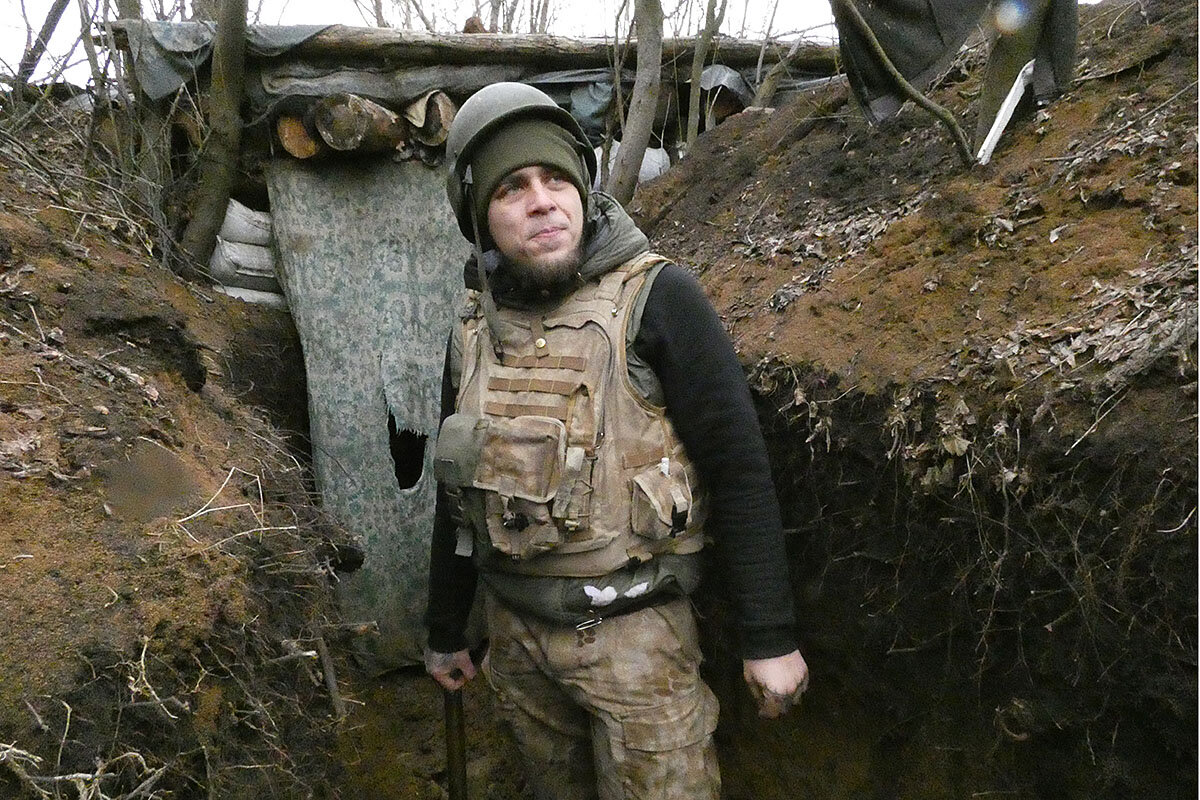
As the West watches warily for a Russian invasion of Ukraine, tensions have spiked between Ukrainian and Russian-backed separatist forces in southeastern Ukraine’s Luhansk and Donetsk regions. The Ukrainian military has reported more than 50 attacks on its front-line positions over the past 48 hours.
But Ukrainian soldiers manning the line say it’s nothing new.
“We have been in this situation now for eight years, so we are used to it,” says Andrei Vitaliovych, who enlisted when war erupted in Luhansk and Donetsk. “The talk of invasion – it doesn’t affect us.”
In Niu-York, a village in Donetsk, residents and troops offer a similar perspective. Olha Mykolaivna, a mother of two young sons, ascribes the lack of public panic to the steady presence and improved capability of Ukraine’s military.
“I believe that our soldiers can protect us,” she says, speaking in Russian, the predominant language of Donbass. She and her husband stopped by a bakery to pick up pastries and bread on their way home to dinner. Each wears a face mask adorned with a small Ukrainian flag.
“The Russian government wants us to be afraid,” she says. “But we can see what they are doing. It is nothing new.”
For Ukrainians on the front line, Russian threat is just part of life
Andrei Vitaliovych peers through a handheld periscope over the top of a trench wall at a line of barren trees some 350 yards away. The junior sergeant with the Ukrainian army explains that the trees mark the front-line position of Russian-backed separatist fighters near this mining town of 13,000 residents in southeastern Ukraine.
“When the wind is right, you hear them talking,” he says, stepping down into the trench and sinking ankle-deep into mud as thick as clay. “They probably hear us sometimes.”
On Thursday, the enemy was more audible – and more menacing. Artillery and mortar rounds fired from rebel-occupied territory thudded into the wet earth a half-mile from the trenches patrolled by Sergeant Vitaliovych’s unit with the 24th Mechanized Brigade.
The shelling occurred as tensions spiked between Ukrainian and separatist forces in the southern portions of the Luhansk and Donetsk regions along the Russian border that rebels have held since 2014.
The Ukrainian military has reported more than 50 attacks on its front-line positions over the past 48 hours. In Stanytsia Luhanska, east of Zolote, a rocket struck a kindergarten and wounded three people Thursday. Separatist leaders claimed government forces fired mortars and grenades into occupied areas in multiple incidents during the same period, and earlier Friday announced a large-scale evacuation of residents.
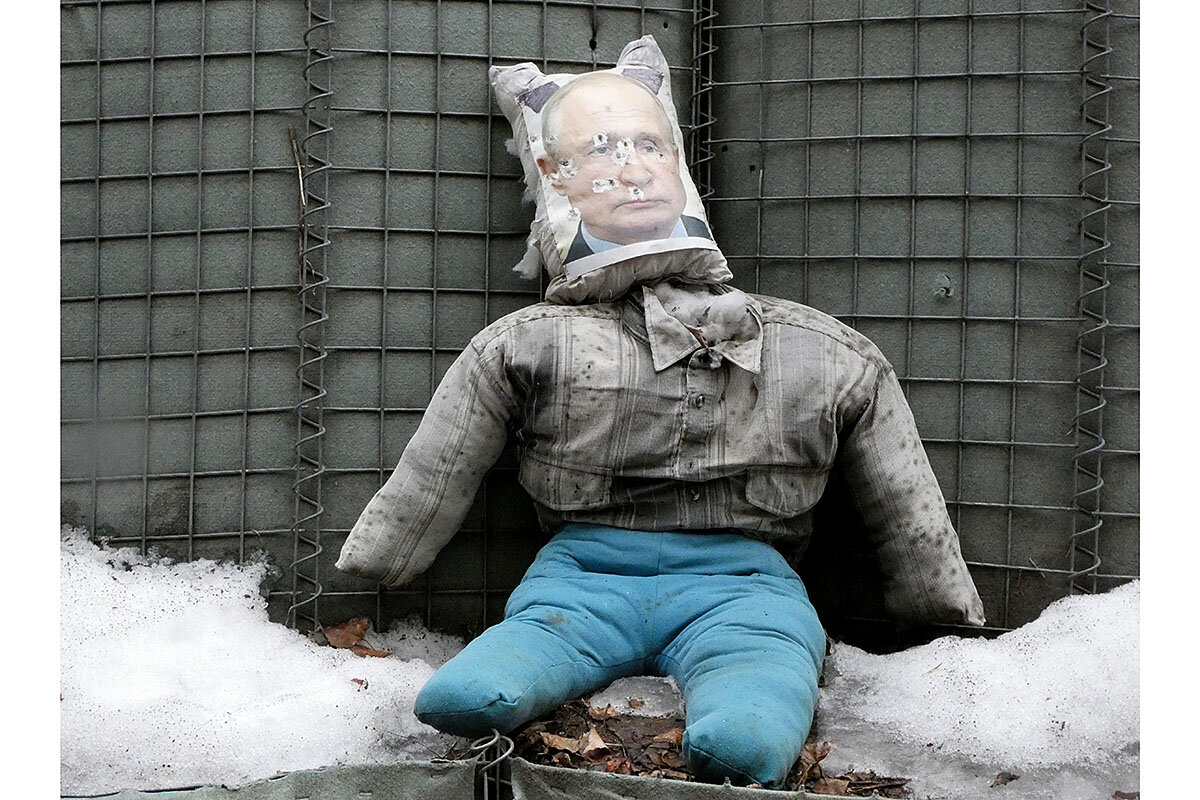
Ukrainian President Volodymyr Zelenskyy called the kindergarten shelling a “big provocation” as U.S. President Joe Biden warned that the threat of a Russian invasion of its neighbor remained “very high.” Mr. Zelenskyy attended a security conference Friday in Munich to meet with German Chancellor Olaf Scholz, U.S. Vice President Kamala Harris, and other world leaders. Mr. Biden was scheduled to talk with NATO allies as they seek a diplomatic resolution to the crisis.
The Organization for Security and Cooperation in Europe reported Friday that Russia has deployed up to 190,000 troops along Ukraine’s border. In the shadow of that buildup, and in contrast to rising fears in the West of Russia’s intentions, a sense of calm prevailed this week among soldiers and villagers in Zolote and elsewhere near the front lines.
“We have been in this situation now for eight years, so we are used to it,” says Sergeant Vitaliovych, who enlisted when war erupted in Luhansk and Donetsk, an industrial region of the country known as Donbass. He speaks with casual affability amid the occasional boom of incoming artillery, swinging the pipe periscope at his side as if strolling with an umbrella in his hometown village outside the western city of Lviv.
“The talk of invasion – it doesn’t affect us,” says Sergeant Vitaliovych, the father of a 3-year-old daughter with his wife, a fellow soldier. “We will be ready, the same as always.”
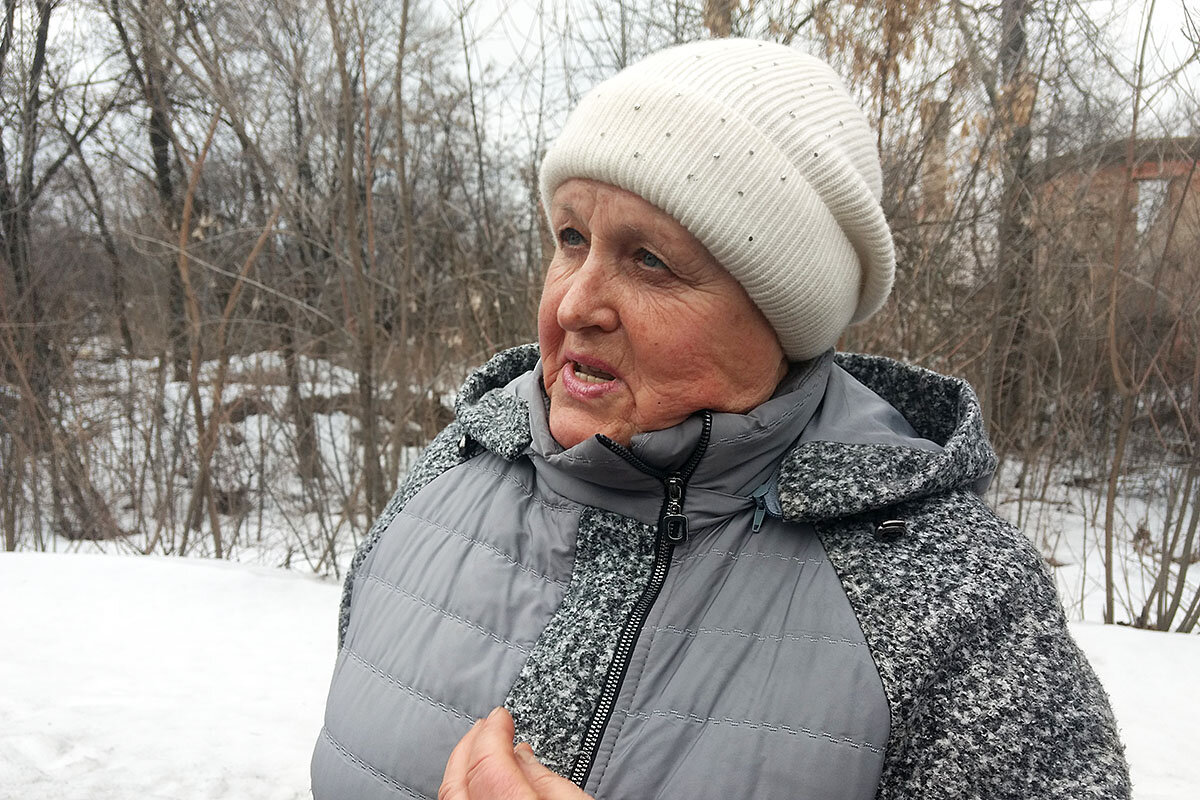
“We have to go on living”
Dozens of homes and businesses in Zolote bear the scars of war – rooftops blown open by artillery, walls pockmarked by bullets and shrapnel – and separatists retain control of one section of the village.
Yet for Anhelina Polishchuk, an area native and a grandmother, neither the sound of rocket fire nor the exchange of accusations between Ukrainian and Russian officials provokes cause for concern.
“I’m not worried,” she says, pausing on her walk home from a nearby market. She wears a stylish zip-up coat to keep out the cold, and the flower design on her tote bag lends a dash of springtime brightness to winter’s gray-white tableau. “You hear some shooting or some rockets, but you can’t let that scare you. We have to go on living.”
In Niu-York, a village in Donetsk some 50 miles south of Zolote, residents and troops offer a similar perspective. Olha Mykolaivna, a mother of two young sons, ascribes the lack of public panic to the steady presence and improved capability of Ukraine’s military.
“I believe that our soldiers can protect us,” she says, speaking in Russian, the predominant language of Donbass. She and her husband stopped by a bakery to pick up pastries and bread on their way home to dinner. Each wears a face mask adorned with a small Ukrainian flag.
“The Russian government wants us to be afraid,” she says. “But we can see what they are doing. It is nothing new.”

BBC
The war in Luhansk and Donetsk has displaced an estimated 1.5 million people. The army has converted abandoned houses into outposts in Niu-York and across the front line, and its enormous troop carriers now rumble along the town’s narrow dirt roads with the same regularity as municipal buses.
Most of the soldiers with the 46th Air Assault Brigade deployed to the area live beneath the ground’s surface in trenches that form a subterranean maze in and around the village. They profess to worry more about the cold than an invasion.
“I really don’t think anything big is going to happen,” says Vladimir Oros, kneeling down to pet a stray short-coated collie that the unit has adopted. “If it does happen, then we will do what we are here to do: fight.”
His platoon mate, Sergiy Pryhodko, smiles at the comment. “And if we have to fight,” he says, “it will keep us warm.”

BBC

A beef with ‘bigs’: Why rethink of competition starts with meat industry
Has a trend toward corporate bigness gone too far? The meat industry is becoming an important test as President Joe Biden and lawmakers in both parties consider regulatory changes. But the issues involved are complex.

- Quick Read
- Deep Read ( 6 Min. )
“Capitalism without competition isn’t capitalism. It’s exploitation,” President Joe Biden said last month in announcing a plan to help smaller meat processors.
It’s not just agriculture. While few would go as far as breaking up companies, the idea that concentrated corporate power needs more government oversight is catching on. From academia to Congress to the White House, people are reconsidering “bigness.”
The industries getting the most scrutiny so far, from both sides of the political spectrum, are Big Tech and meat. Within the meat industry, a top concern is that reliance on a few players and their few big, efficient operations may weaken the economy’s resilience if some of those plants have to close down because of a pandemic or some other challenge.
The reality is nuanced. A 2021 study for the National Bureau of Economic Research found that while concentration increased in consumer-facing industries over the past quarter-century, competition can remain vibrant as the strongest players roll out new products to compete with one another.
U.S. meat prices are lower than in Europe, which has adapted a model closer to what reformers are proposing. Still, some ranchers and economists welcome the winds of regulatory change with a focus on resilience.
A beef with ‘bigs’: Why rethink of competition starts with meat industry
Mike Callicrate doesn’t mince words: “Break ‘em up,” says the Kansas cattleman of the four meatpackers that dominate his industry. “We’ve got to have a different model going forward. It’s going to be a smaller, more local, regional model.”
It’s a notion that is gaining attention, and not just in agriculture. While few would go as far as breaking up companies, the idea that concentrated corporate power needs more government oversight is catching on. From academia to Congress to the White House, people are reconsidering “bigness.”
The industries getting the most scrutiny so far are Big Tech and meat. Complaints about the reach and influence of giant technology companies such as Meta (formerly Facebook) are rising from both sides of the political spectrum. And shutdowns of huge packing plants before and during the pandemic, which sent meat prices soaring, have caused the White House – as well as bipartisan groups of rural-state senators – to propose new steps for reform. The idea is: Reliance on a few players with big, efficient operations may be hurting the economy’s resilience in the face of unexpected challenges.
Even some economists are beginning to reconsider their devotion to efficiency and are asking: “Should we start thinking about sacrificing some cost and efficiency to guard against future pandemics?” says Azzeddine Azzam, an agricultural economist at the University of Nebraska, Lincoln.
Big meatpackers have survived public scrutiny before, such as food-safety scandals in the early 1900s and price-fixing concerns in the 1920s. Today’s talk of resilience, however, poses a bigger challenge because it goes to the heart of how the industry is set up. “It represents a larger potential for change than food safety,” says Bill Winders, a sociologist at Georgia Tech in Atlanta and co-editor of “Global Meat,” a 2019 book on the industry.
Four big companies
Four international corporations control 85% of U.S. beef processing capacity, according to the White House: JBS S.A., the world’s biggest meat supplier; Tyson Foods Inc., the biggest U.S. meat company by sales; Cargill Inc., the nation’s largest privately held corporation; and National Beef Packing. The other popular meats – pork and poultry – are also highly concentrated and controlled by some of the same players. But beef is drawing the most attention, in part because it’s the most concentrated and also because it’s an inflation leader, with an 11% jump that’s the fastest 12-month rise in beef prices in four decades.
The Biden administration blames much of that price rise on the lack of competition within the meat industry. “Capitalism without competition isn’t capitalism. It’s exploitation,” President Joe Biden said last month in announcing his plan to help smaller processors, the same phrase he used last July when signing an executive order taking on Big Tech’s anticompetitive practices.
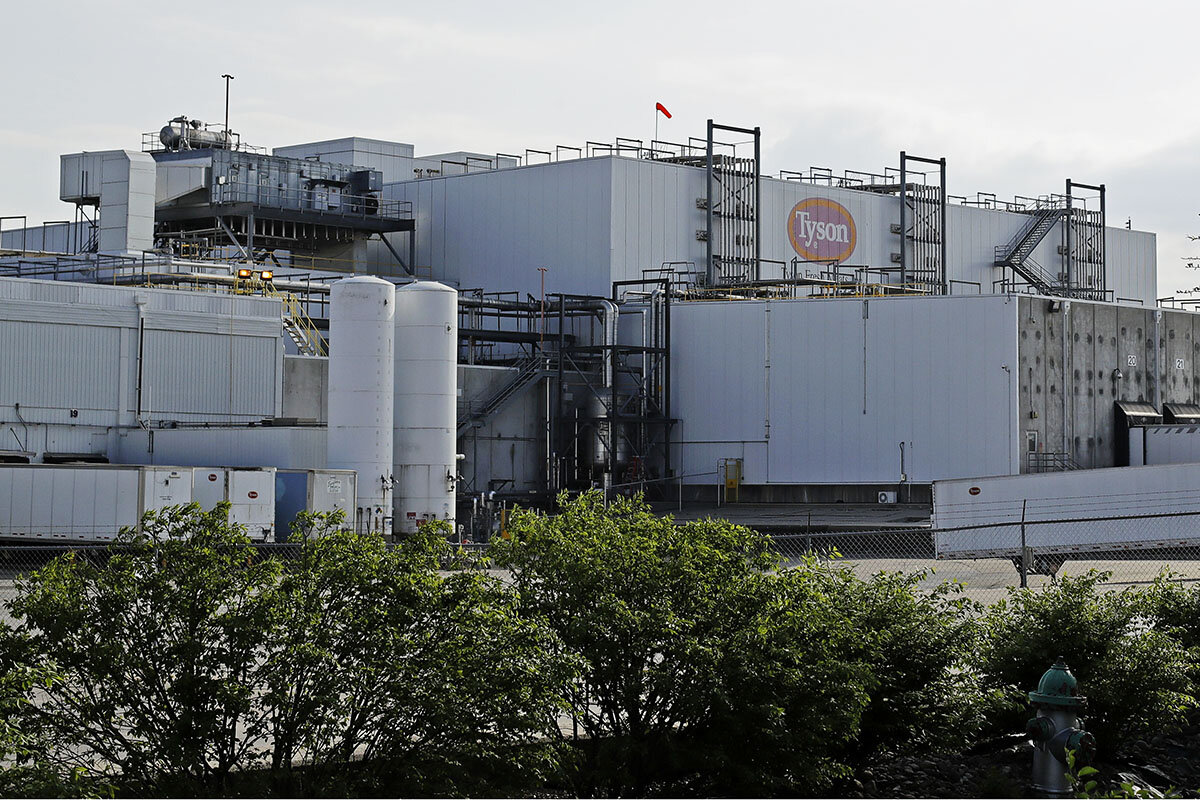
But the reality is more complex. Weather, an historic drought in the West, the constant supply adjustments by ranchers to price signals, plus changes in consumer demand brought on by the pandemic have had a big impact on meat prices. “The Biden Administration continues to ignore the number one challenge to meat and poultry production: labor shortages,” Julie Anna Potts, president and CEO of the North American Meat Institute, said in a statement last month.
With bigness, efficiency
Nor is it clear that bigness is always bad. A 2021 study for the National Bureau of Economic Research found that while concentration increased in consumer-facing industries over the past quarter-century (think airlines or rental cars), product concentration actually went down. In other words, the more dominant corporations became, the more fiercely they competed with each other, crashing rivals’ markets with new products of their own. And the efficiency of the big packers has kept meat prices low for American consumers over the long term, certainly lower than in Europe, which has adapted a model closer to what reformers are proposing.
And while the big processors have been squeezing ranchers, taking a bigger and bigger share of the consumer dollar spent on beef, their extreme efficiency has allowed them to afford to pay ranchers more than they otherwise would get, says professor Azzam, the University of Nebraska economist. That sounds contradictory, but packers don’t want to build an expensive plant and then wipe out their suppliers, he points out. The packers’ efficiency-powered profits give them more leeway to pay ranchers what they need to stay in business.
But there are also costs to bigness – some apparent and some hidden. (Neither the meat institute, which represents the processors, nor three of the biggest processors themselves responded to emails for comment.)
One is wages. By moving plants from the Corn Belt to the Great Plains to get plants closer to ranchers, processors were also able to shed unionized workers and replace them with rural, poorly paid, nonunion – and eventually immigrant – labor. Another is manipulating prices. JBS, Tyson, and pork-processing giant Smithfield Foods have all settled lawsuits for price fixing.
Then there are the environmental and health problems. Because the processing plants are so big, they generate enormous amounts of waste. Last year, for example, Tyson agreed to a $3 million settlement for releasing thousands of gallons of partially treated wastewater into an Alabama river, killing an estimated 175,000 fish. The five largest meat processors also were hit hard by the pandemic, with at least 269 worker deaths attributed to COVID-19 in the first year of the pandemic, according to a House select subcommittee.
To counter this market power, the Biden administration has a plan that would extend $1 billion in federal aid to small processors and expand and strengthen regulations to try to level the playing field.
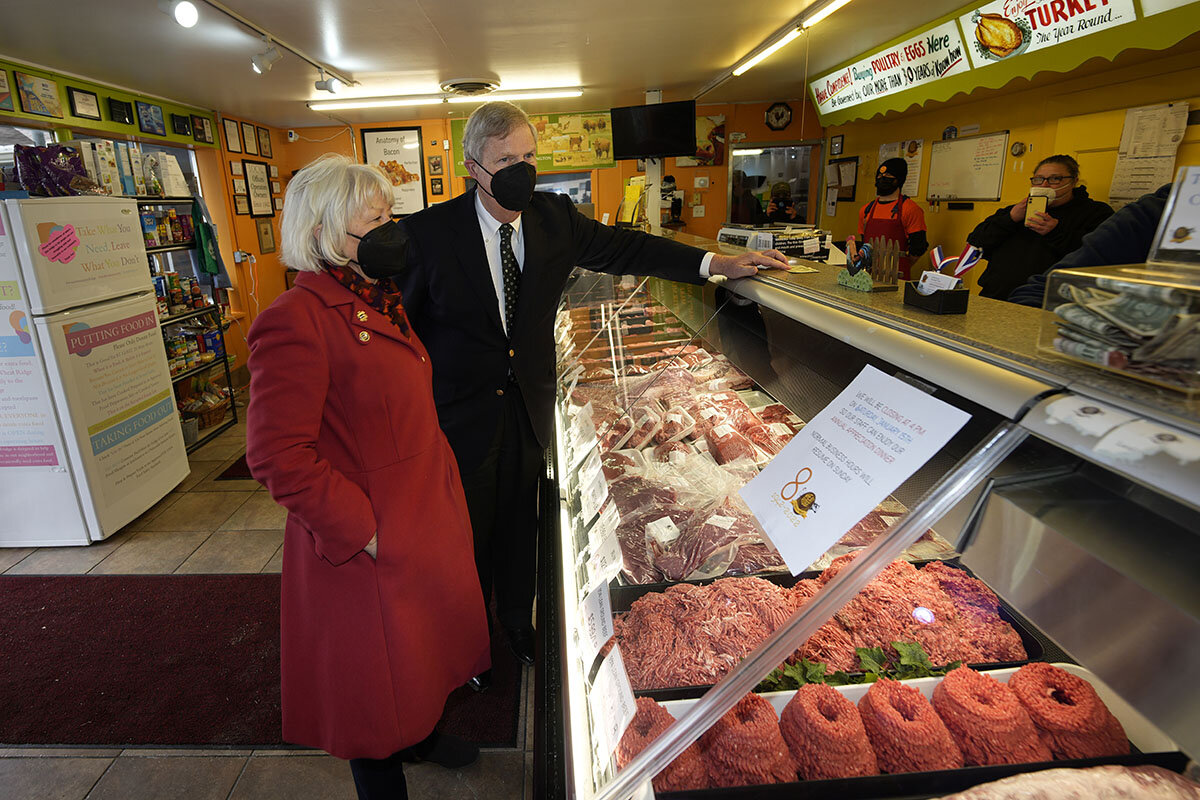
A new political climate in Congress
Efforts at reforming the industry are also underway in Congress – and in a bipartisan way. Republican Sens. Chuck Grassley of Iowa and Deb Fischer of Nebraska have joined with Democratic Sens. Jon Tester of Montana and Ron Wyden of Oregon to require that packers buy a certain amount of their beef on the cash market, rather than rely on private contracts whose terms are not disclosed. The idea is to make price-setting more transparent.
Last fall, a larger bipartisan group of senators also introduced a bill to reinstate the American Beef Labeling Act, so U.S. meatpackers would no longer be allowed to put a U.S. label on beef imported from abroad. Even small processors who might benefit from the Biden program doubt that such measures will come close to leveling the playing field. “We really appreciate what the Biden administration is trying to do,” says Mike Lorentz of Lorentz Meats, a niche meat processor based in Cannon Falls, Minnesota. And “we have grown exponentially in the past 20 years. But we are still not even a blip on the radar.”
The difference in operating scale is just too great to overcome – and not just in beef, but in pork and poultry as well. Mark Curran and Bill Kuhnert, partners in Vermont Family Farms, which buys cattle and hogs from small farms and aggregates them into lots that can be sold to niche processors, say they can get 120 hogs processed a day. But they point out that Smithfield’s Tar Heel, North Carolina, plant, the world’s largest, processes 32,000 hogs a day. “It’s just so far apart,” Mr. Curran says. “You’d need a whole lot of plants to get close to matching that or have any meaningful impact.”
The political power is also tilted in favor of the bigs.
When President Biden was vice president, President Obama proposed strengthening federal laws against price fixing in agriculture, “The power of those big processors undermined it, says Philip Howard, a professor in the department of community sustainability at Michigan State University at Lansing. “It’s a different political climate now. [But] it’s going to be difficult to see substantial change.”

To fight pandemic’s uncertainty, Germans embrace a testing culture
Germany’s test-heavy pandemic approach has morphed societal psychology to the point that testing – once a hot-button issue for a weary public – has now become part of everyday life.

- Quick Read
- Deep Read ( 4 Min. )
Germany has long been a nation with a collective culture and a reverence for scientific achievement. But two years into the COVID-19 pandemic, those tendencies have been kicked into overdrive. Matter-of-fact acceptance of testing has become part of life.
Rapid testing has long been key to Germany’s COVID-19 strategy, with the government working early to shore up supplies and subsidize costs for the public. In this way, science has always been at the forefront of Germany’s pandemic response.
Across Germany, public trust in science is higher now – by about 10 to 15 percentage points – than before the pandemic, according to the multiyear “Science Barometer” study.
Overall, this increased gravitation toward science is a positive development, sociologists say. “I think it’s really important that people are open to the struggle of science to provide answers to important questions facing society,” says Gerald Echterhoff, professor of social psychology at the University of Münster.
He adds that this shift might have lasting effects in other crisis management efforts, like “climate change, where people need to really assume responsibility, and live with restrictions in order to deal with the things that will be important for the benefit of society and social cohesion.”
To fight pandemic’s uncertainty, Germans embrace a testing culture

Max Diel wanted to go out to dinner, even with a pandemic rampant in Germany.
So the Berlin-based artist sauntered into one of the more than 15,000 free test centers that have popped up all over the country and got in line. Navigating the sign-up app was challenging, he says, and waiting in line can be annoying. But he got his free test result and an hour later, he was meeting with friends.
Though Germany is now considering loosening some pandemic restrictions within a month, for nearly a year, simply attending school, visiting a restaurant, or shopping at a clothing store has at times required showing a negative test result.
“I don’t see anything negative about the testing,” says Mr. Diel. “It just gives you the possibility to live with more freedom.”
Germany has long been a nation with a collective culture and a reverence for scientific achievement. But two years into the COVID-19 pandemic, those tendencies have been kicked into overdrive. Matter-of-fact acceptance of testing has become part of life, and public trust in science is also higher now than before the pandemic.
Sociologists say German society will emerge from the pandemic newly practiced on the importance of shared responsibility. And that could have significant implications for how Germany handles future crises – and other imminent ones, like climate change.
“I would say the majority has realized that solidarity is a human resource,” says Heinz Bude, a professor of macrosociology at the University of Kassel. “People see and realize we need collective action for situations we can’t imagine for the moment, but which might possibly arise in the future.”
Science and responsibility
Rapid testing has long been key to Germany’s COVID-19 strategy, with the government working early to shore up supplies and subsidize costs for the public. In this way, science has always been at the forefront of Germany’s pandemic response.
German virologist Christian Drosten, who co-discovered the SARS coronavirus two decades ago, now consults the government on its COVID-19 response. Two married German scientists who started the company BioNTech developed the vaccine now marketed worldwide by Pfizer. Angela Merkel, chancellor when the pandemic started, holds a doctorate in quantum chemistry and refused to dumb down science while addressing the public.
Across Germany, public trust in science is higher now – by about 10 to 15 percentage points – than before the pandemic, according to the multiyear “Science Barometer” study out of the Wissenschaft im Dialog, the German organization for science communication.
Further, more than two-thirds of respondents now expect politicians to be guided by scientific findings.
Science was boosted by what sociologist Rudolf Stichweh called the “simplification of social life,” where society’s singular imperative was to save as many individual lives as possible.
“It was kind of a hegemony of the health and science system, subordinating other systems of society to look at what science would tell us,” says Gerald Echterhoff, professor of social psychology at the University of Münster.
Overall, this increased gravitation toward science is a positive development, sociologists say. “I think it’s really important that people are open to the struggle of science to provide answers to important questions facing society,” says Dr. Echterhoff. “I welcome the shift.”
There’s also the realization of the impact of individual actions on strangers. “There could be an infection chain to people in a senior home, right? And it could kill people, right?” says Dr. Echterhoff. “And that has become part of common knowledge and understanding.”
Society shoulders the burden
Overall, this societal shift hasn’t occurred without glitches, and it hasn’t always come from a place of selfless motivation. There’s a vocal minority who protests pandemic restrictions. Certain groups of people have also fallen prey to the “infodemic” of false information around COVID-19 and its treatment.
Further, one could chalk up the new feeling of “collective responsibility” simply to forced compliance. Pandemic restrictions like testing and vaccinations were tolerated by the public in the same way that curbs on smoking were gradually accepted, says Dr. Bude, the macrosociologist. “I think it’s a combination of rational acceptance, and of course, of institutional authority,” he says. “It’s both.”
Testing was also used as a tool, which ultimately allowed politicians to feel as if they could sidestep the negative impact of ongoing coronavirus restrictions. Those included depression, unemployment from retail and restaurant shutdowns, and lack of access to government services, says James Moore, a history professor at Humboldt University of Berlin.
“In this way, the testing campaign contributed negatively to living a normal life,” says Dr. Moore. “The conversation seemed only to be [limited to] the domain of testing and vaccines. As far as I can tell, the governments did not consult sociologists, and what kind of sociological training does a virologist or immunologist have?”
Yet, perhaps this shift might yet morph into a lasting post-pandemic consciousness about crisis management, says Dr. Echterhoff. “I mean climate change, where people need to really assume responsibility, and live with restrictions in order to deal with the things that will be important for the benefit of society and social cohesion.”
“That’s what I’m hoping for.”

Points of Progress
French drains, barrels for rain, and a wind-energy bullet train
In our progress roundup, action on climate change and fossil fuels comes from the top down and bottom up. While Morocco’s rail system moves to renewables to power its fastest trains, citizens in New Orleans are building their own flood prevention mechanisms.
French drains, barrels for rain, and a wind-energy bullet train
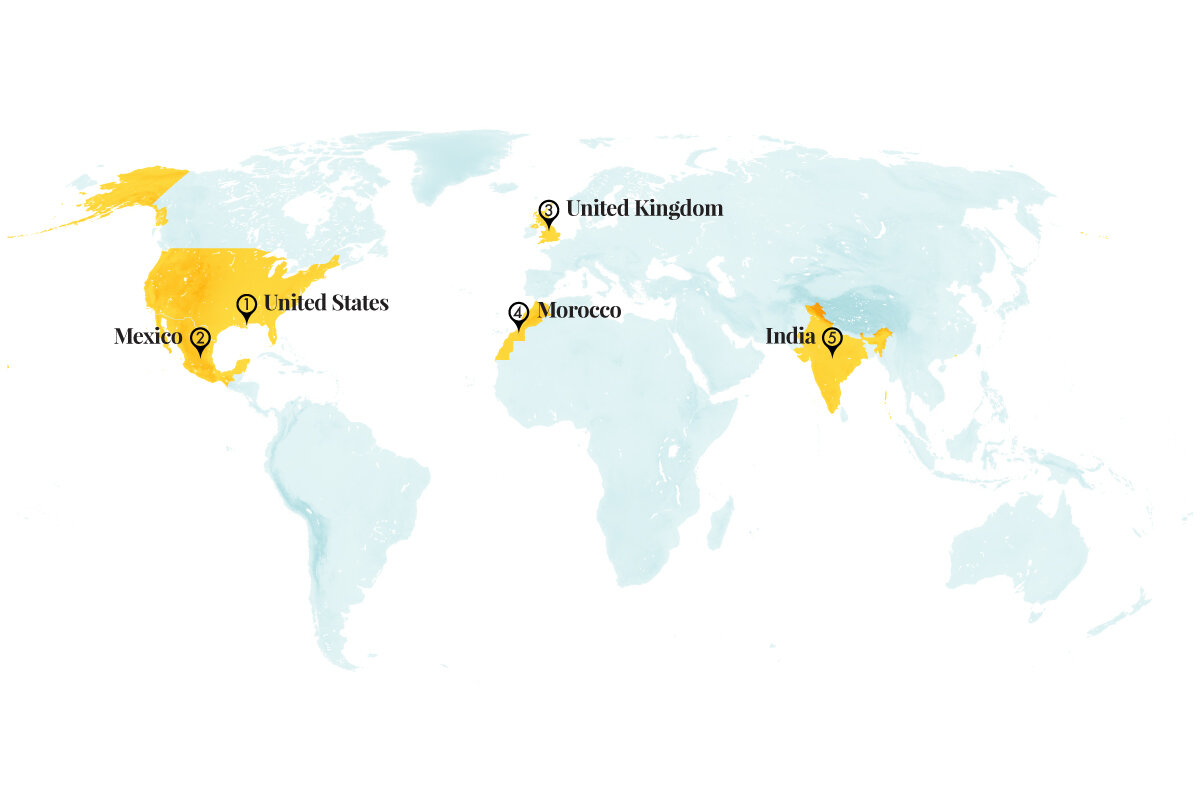
Along with environmental strategies from the Americas to North Africa, we highlight legal advances in India and the United Kingdom that help correct errors of the past.
1. United States
New Orleans residents are banding together to build green infrastructure, preventing flooding before storms hit. Chronic flooding has long been a problem across the Gulf South, and climate change is making matters worse. Experts say New Orleans’ public infrastructure, including its levee system, isn’t enough to keep flooding at bay. That’s why the nonprofit Water Wise Gulf South is helping communities in marginalized areas design and build alternatives to traditional “gray” infrastructure, using a water management approach that protects, restores, or mimics the water cycle in nature.
So far, over 500 residents have taken part in workshops to learn how to implement do-it-yourself projects at home, and many of them have participated in “Visioning Workshops” to plan community infrastructure. In the 7th Ward, residents have installed 25 rain barrels, eight French drains, seven rain gardens, and two permeable parking pads, and planted more than 500 trees. Last fall, they began work on their first bioswale, a vegetated stormwater runoff system that captures and filters water. “Government is slow and we can’t wait for government to catch up to us,” says 7th Ward resident Angela Chalk, who helped install the bioswale. “All of us in these communities realize we have to get this right and that climate change is not waiting. We can’t wait.”
Next City
2. Mexico
The tequila splitfin – once declared extinct – has been reintroduced in the wild. The orange-tailed fish, which fits in the palm of a hand, was nicknamed “little rooster” before it disappeared from the Teuchitlán River in central-western Mexico in the 1990s, likely due to pollution, poaching, and the construction of a dam.

In 1998, Chester Zoo in England offered Michoacana University of Mexico five pairs of the splitfins from collectors’ aquariums, whose offspring scientists cared for over the next 15 years. Following a promising test in large artificial ponds, scientists released 1,500 of the fish into the river – first in floating cages, then in the open. Now, the population continues to expand.
Researchers employed a local education campaign including puppetry, games, and facts such as the fish’s efficiency in keeping dengue-carrying mosquitoes under control. Residents, many of them children, are calling themselves “river guardians” and helping keep the river clean. “We couldn’t have done this without the local people – they’re the ones doing the long-term conservation,” said Professor Omar Dominguez from Michoacana University. The project is a 2018 International Union for Conservation of Nature case study in successful reintroductions.
BBC, The Associated Press
3. United Kingdom
Britain expanded legal pardons for gay men criminalized under historical statutes. The new law builds on Turing’s Law, named for the code breaker and World War II hero who was convicted of “gross indecency” and died in 1954. The 2017 statute pardoned men convicted of nine since-abolished offenses; this year’s law covers all convictions linked to consensual same-sex activity.
The move is one piece of the U.K.’s commitment to “righting the wrongs of the past,” as Home Secretary Priti Patel said. New pardons can’t change the past: Men criminalized for their sexual orientation often faced discrimination throughout their lives.
Rights advocates point out that individuals must still apply to have their convictions removed, but legal pardoning represents a step forward.
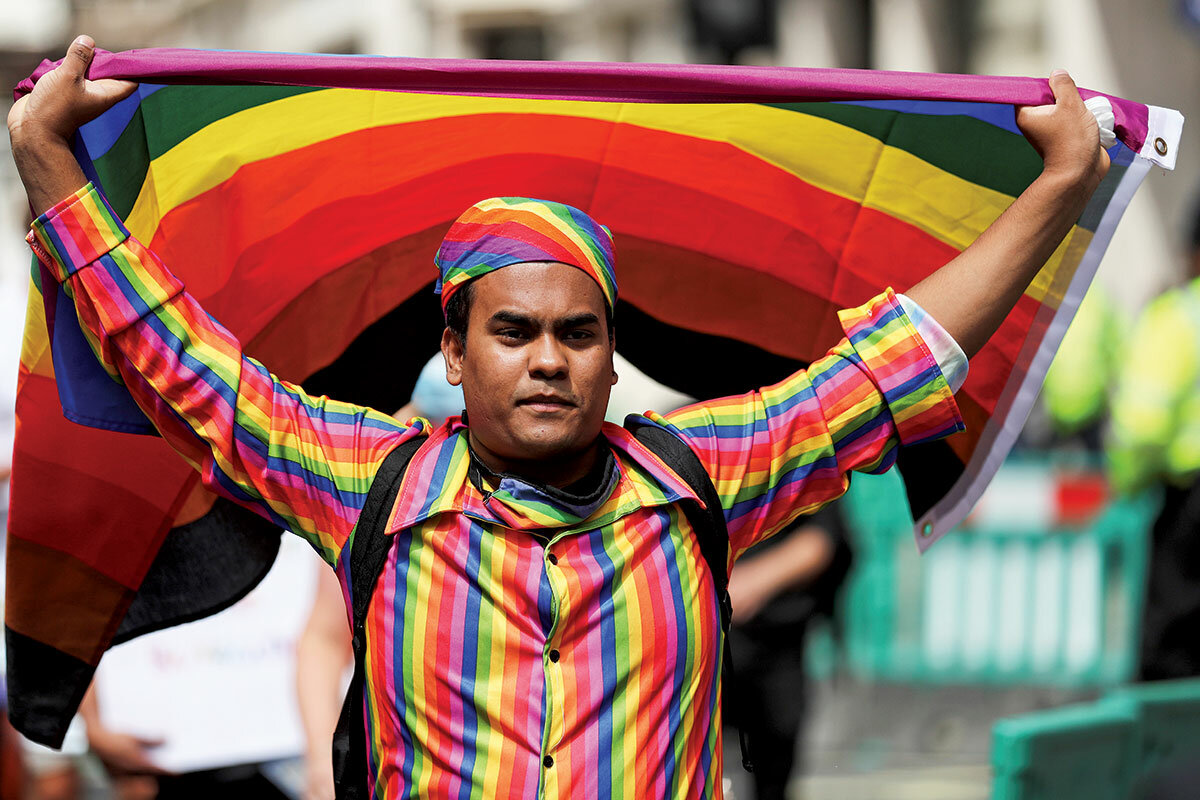
“It recognizes the extraordinary scale of injustice done to so many people over a long period of time, and offers, as far as possible, restitution,” said Paul Johnson, a professor of social sciences at the University of Leeds. “It draws a line under five centuries of state-sanctioned persecution of gay people and says: ‘never again.’”
Thomson Reuters Foundation, NBC News, The New York Times
4. Morocco
A high-speed rail service between Casablanca and Tangier is switching to renewable energy. The Al Boraq line, inaugurated in 2018 as Africa’s first bullet train, stretches 200 miles across Morocco with trains that travel at 186 mph – comparable to traveling between New York and Washington, D.C., in 90 minutes. Now, Al Boraq trains will use 100% wind energy as part of the National Railways Office’s plan to increase renewable energy usage to 50% in 2023, before transitioning entirely. The office says it can avoid the production of 120,000 metric tons of CO2 emissions each year through these efforts and other partnerships.
Morocco started to become a regional leader in clean energy in the mid-2000s, committing to renewables to boost economic competitiveness and reduce dependence on foreign fossil fuels. Despite missing a 2009 goal of 42% renewable energy by 2020, the government hasn’t let up on its ambitious targets. Morocco plans to produce 52% of its energy from renewable sources by 2030, with 20% solar, 20% wind, and 12% hydropower. If successful, the North African country would be at the global forefront of clean energy.
Morocco World News, BBC
5. India
An Indian court held two mining companies legally accountable for polluting the local environment – and now they must help clean up. For 10 years, farmer Manbodh Biswal fought for compensation for the damage the Talabira-I coal mine inflicted on his land in the eastern state of Odisha. “We used to harvest two crops a year but now just manage to grow some vegetables,” said Mr. Biswal, who like many in India lives in a region rich in minerals but poor in other resources. “Our access to the farms has been restricted by hills of excavated earth from the mines. Irrigation water is polluted, coal dust is everywhere.”
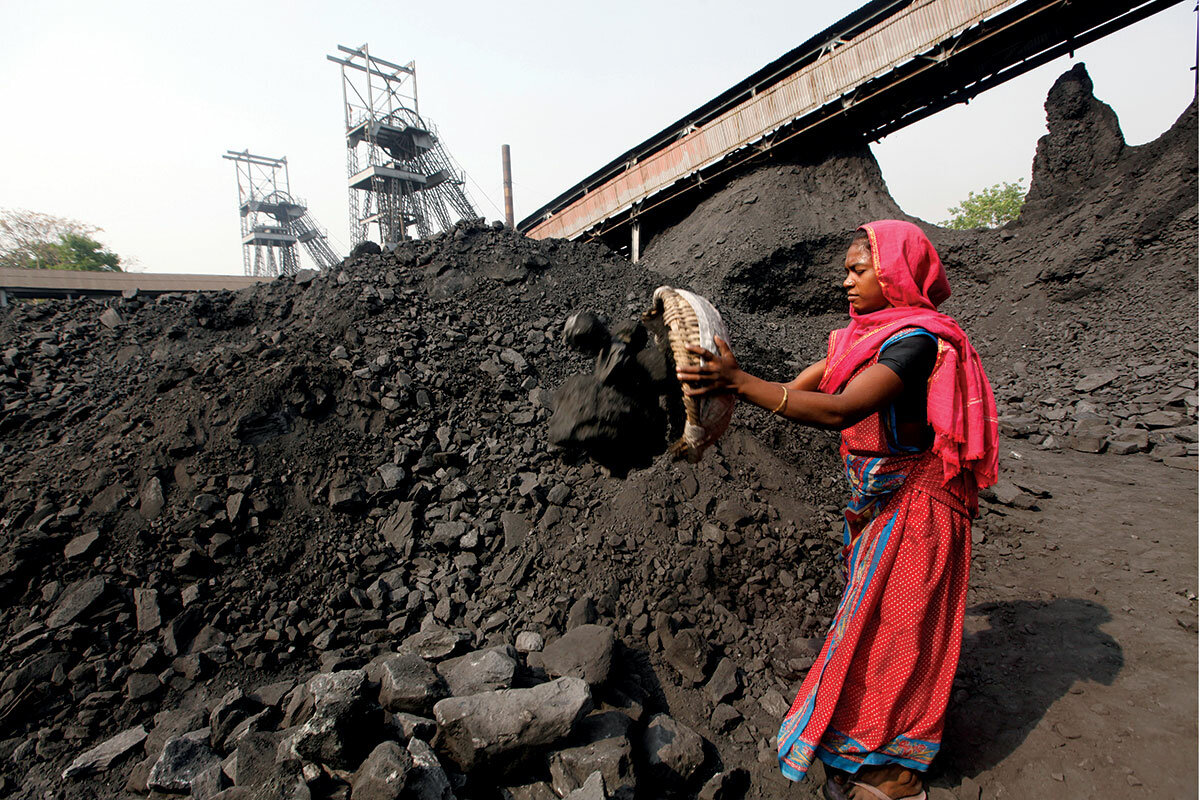
Now, three years after the mine closed, the National Green Tribunal has ordered Hindalco Industries and Raipur Energen to pay 100 million Indian rupees ($1.32 million) to rehabilitate the “critically polluted” area, helping restore the farmland of Mr. Biswal and other villagers. Since 2008, some 123 coal mines have shut down across India, but pollution continues to burden communities. For environmentalists and social justice advocates, the court win – a feat deemed “quite rare” by Mr. Biswal’s lawyer – is a sign that land and community restoration are being taken seriously.
Thomson Reuters Foundation
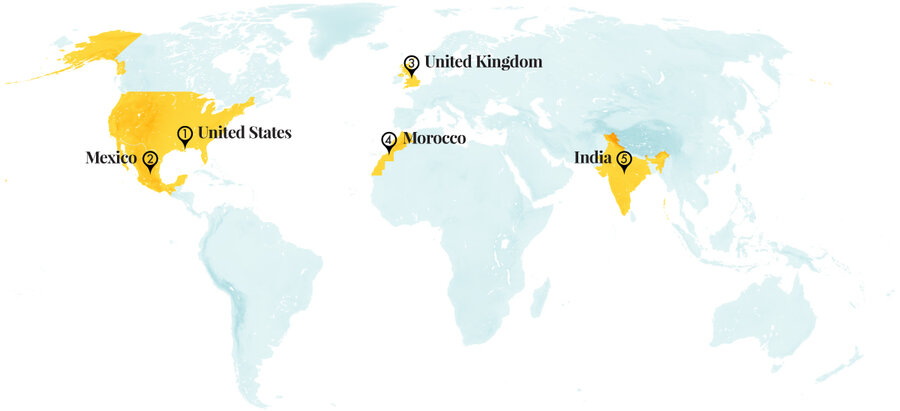
Other headline stories we’re watching
(Get live updates throughout the day.)The Monitor's View
Deeper solutions to Africa’s Islamist violence
- Quick Read
- Deep Read ( 3 Min. )
-
By the Monitor's Editorial Board
Across Nigeria, tensions between farmers and nomadic herders keep escalating, driven by a competition for land and water made worse by population growth and climate change. These skirmishes receive less attention than the region’s violent Islamist insurgencies. Yet they take a greater toll in killings and village disruptions, according to the United States Institute of Peace. They may also be one key to bringing peace in this region of Africa.
In at least two Nigerian states, new local peace agencies are quietly working with traditional leaders to stitch communities back together. Instead of security by military force, they are building what a mediator in the state of Kaduna calls “an atmosphere of understanding” through dialogue and reconciliation. Their successes show a way forward at a fragile turning point in efforts to suppress groups like Boko Haram and Islamic State.
A decade of fighting Islamist extremism in West Africa has killed thousands and displaced millions from their homes. As Western and African leaders reassess a primarily military-based approach to countering terrorism, people in communities overrun by that violence are showing that divisions based on identity can be overcome. By restoring local currencies of trust and respect, they are learning how to put down their guns.
Deeper solutions to Africa’s Islamist violence

Across Nigeria, tensions between farmers and nomadic herders keep escalating, driven by a competition for land and water made worse by population growth and climate change. These skirmishes receive less attention than the region’s violent Islamist insurgencies. Yet they take a greater toll in killings and village disruptions, according to the United States Institute of Peace (USIP). They may also be one key to bringing peace in this region of Africa.
In at least two Nigerian states, new local peace agencies are quietly working with traditional leaders to stitch communities back together. Instead of security by military force, they are building what a mediator in the state of Kaduna calls “an atmosphere of understanding” through dialogue and reconciliation. Their successes show a way forward at a fragile turning point in efforts to suppress groups like Boko Haram and Islamic State.
For more than a decade, villages across the scrubby lower band of the Sahara desert called the Sahel have been caught in the crossfire between extremist factions and the military forces fighting them. Schools have been prime targets for jihadis looking for wives and conscripts. But civilians have also experienced violence from those who were supposed to protect them, according to human rights groups. And despite the presence of 12,000 United Nations troops and thousands of American and European forces, the problem has continued to spread.
The traumatic disruption of communities has created conditions that make people, particularly young men, more susceptible to radicalization. It is also causing a crisis of faith in democracy. In Mali, for example, the failure of international forces to contain extremism has turned popular opinion in favor of a ruling military junta even though 75% of the people say they favor democracy, according to the polling firm Afrobarometer.
The crisis deepened at a summit of European and African leaders in France this week. French President Emmanuel Macron announced he was withdrawing the 4,600 French troops based in Mali as part of an international counterterrorism operation. Critics called it an admission of failure. France has had troops in Mali to fight Islamist insurgents since 2013. But Mr. Macron said he could no longer side with “de facto authorities” that have lately embraced the arrival of some 800 Russian mercenaries. Denmark, Germany, and Norway are withdrawing their military support as well.
African leaders at the summit sided with Mr. Macron. Their opposition to the military junta in Mali reflects a shared conviction that lawlessness through military rule is not the answer to lawlessness. But it leaves unresolved how best to fix a security problem that has defied the use of international forces.
In Nigeria, communities responding to ethnic and religious strife from within may hold part of the answer. Peace initiatives like the ones bringing herders and farmers together “are an instrument worth adapting elsewhere to strengthen democracies against the erosions of violence and extremism,” USIP notes. They start slowly. State-sponsored mediators bring traditional leaders together to begin defusing suspicions. Gradually others are involved. Storytelling helps participants find common ground.
A decade of fighting Islamist extremism in West Africa has killed thousands and displaced millions from their homes. As Western and African leaders reassess a primarily military-based approach to countering terrorism, people in communities overrun by that violence are showing that divisions based on identity can be overcome. By restoring local currencies of trust and respect, they are learning how to put down their guns.

A Christian Science Perspective
Each weekday, the Monitor includes one clearly labeled religious article offering spiritual insight on contemporary issues, including the news. The publication – in its various forms – is produced for anyone who cares about the progress of the human endeavor around the world and seeks news reported with compassion, intelligence, and an essentially constructive lens. For many, that caring has religious roots. For many, it does not. The Monitor has always embraced both audiences. The Monitor is owned by a church – The First Church of Christ, Scientist, in Boston – whose founder was concerned with both the state of the world and the quality of available news.
What messages are we listening to?
- Quick Read
- Read or Listen ( 2 Min. )
-
By Amanda Weitman
Looking to God as the ultimate source of truth empowers us to let divine wisdom, not fear, guide us.
What messages are we listening to?
The other day I received a text from someone I didn’t know referring to a purchase I didn’t make. A few hours later, I received another text from the same number that said the receipt for my purchase could be found at the link provided.
I figured this was a phishing expedition, and to confirm this I decided to go to the source – my bank – to see if someone might have access to my credit card. There were no unexpected transactions, so I confidently dismissed the texts as being fraudulent – false suggestions about what was really going on.
This made me think about how there’s a source we can turn to for trustworthy information that goes even deeper. For instance, if fearful thoughts are coming to us, instead of focusing on them we can look to God, the one real source of all reliable information about what’s good and true. Once we do that, we can be confident we’re listening to the right message. That’s because God, good, is Truth itself, and helps us to know our true nature as God’s always cared-for spiritual offspring.
Mary Baker Eddy, the Discoverer and Founder of Christian Science, said in her “Miscellaneous Writings 1883-1896,” “He who refuses to be influenced by any but the divine Mind, commits his way to God, and rises superior to suggestions from an evil source” (p. 113). Mrs. Eddy is referring to God here when she says “divine Mind.”
Every day there are suggestions that our lives are lacking in one way or another. That life is a zero-sum game where some win while others lose. That danger is lurking around every corner. That justice and equity don’t apply to everyone. But these are just false suggestions, counterfeits of divine Mind’s spiritual and harmonious creation that is present, right now.
Instead of getting taken in by these suggestions or ignoring them, we can take each thought to God to determine if the message we’re getting comes from our intelligent, divine Mind. If it is unlike God, all good, then we can wisely dismiss it as untrue. Instead, we can listen to the one true, spiritual source that’s been there all along, and that guides us in ways that help and heal.
Adapted from the Feb. 4, 2022, Christian Science Daily Lift podcast.

A message of love
High speeds, close quarters

A look ahead
Thanks for joining us. On Monday, look for a special send with a sneak peek at our newest podcast, “Say That Again?” We’ll be back with a new Daily on Tuesday, with more on the Ukraine crisis. And between now and then, our “First Look” section is a place to go for breaking news.



